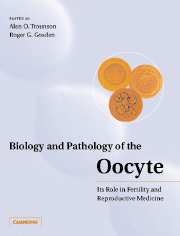Book contents
- Frontmatter
- Contents
- List of contributors
- Preface
- Part I Historical perspective
- Part II Life cycle
- Part III Developmental biology
- 6 Oocyte-specific gene expression: roles in folliculogenesis, fertilization and early development
- 7 Storage and functional recovery of molecules in oocytes
- 8 Endocrine regulation of meiosis - local and systemic hormonal influences
- 9 Checkpoint controls in mammalian oocytes
- 10 Fertilization: fate of sperm components after ICSI
- 11 Activation of the mammalian egg
- 12 Clinical applications in symmetry, asymmetry and polarity in early human development
- Part IV Pathology
- Part V Technology and clinical medicine
- Index
10 - Fertilization: fate of sperm components after ICSI
from Part III - Developmental biology
Published online by Cambridge University Press: 05 August 2016
- Frontmatter
- Contents
- List of contributors
- Preface
- Part I Historical perspective
- Part II Life cycle
- Part III Developmental biology
- 6 Oocyte-specific gene expression: roles in folliculogenesis, fertilization and early development
- 7 Storage and functional recovery of molecules in oocytes
- 8 Endocrine regulation of meiosis - local and systemic hormonal influences
- 9 Checkpoint controls in mammalian oocytes
- 10 Fertilization: fate of sperm components after ICSI
- 11 Activation of the mammalian egg
- 12 Clinical applications in symmetry, asymmetry and polarity in early human development
- Part IV Pathology
- Part V Technology and clinical medicine
- Index
Summary
Introduction
During natural fertilization, the sperm undergoes an irreversible alteration, the acrosome reaction, thereby mediating sperm-oocyte interactions (reviewed by Fawcett, 1975; Yanagimachi, 1994; Wassarman, 1999). The acrosomal contents include hydrolytic enzymes that permit the sperm to penetrate the egg's zona pellucida, as well as proteins and glycoproteins that bind the sperm to the egg (reviewed by Guraya, 2000). Once bound to the oolemma, the sperm perinuclear theca, a cytoskeletal structure intercalated between the sperm plasma membrane and nuclear envelope, is removed from the sperm nucleus (Sutovsky et al., 1997). Consequently, the modified sperm may now proceed with male pronucleus formation. Interestingly, one of the major differences between natural fertilization and intracytoplasmic sperm injection (ICSI) is the absence of these sperm modifications. ICSI results in abnormal sperm decondensation (Hewitson et al., 1999), with the unusual retention of vesicleassociated membrane protein (VAMP) and the perinuclear theca, and the exclusion of nuclear mitotic apparatus (NuMA) from the decondensing sperm nuclear apex. Complete male pronuclear remodelling in ICSI oocytes is required prior to replication of either parental genome, indicating a unique Gl to S transition checkpoint during zygotic interphase, i.e. the first cell cycle. These observations demonstrate that the ICSI procedure itself results in irregularities in nuclear remodelling and cell cycle progression which may have implications for the health of ICSI offspring (Bonduelle et al., 1998; Bowenetal, 1998).
Evolution of ICSI
The clinical application of ICSI (Palermo et al, 1992; Van Steirteghem et al., 1993) has revolutionized the field of assisted reproduction. While originally introduced to treat oligospermic men, ICSI was rapidly applied to cases of severe asthenozoospermia and/ or teratozoospermia even though ICSI using suboptimal sperm may pose a long-term risk to the offspring (In't Veld et al, 1995; Silber et al., 1995; Kent-First et al., 1996; and reviewed by Vogt, 1995). ICSI has more recently evolved to treat cases of severe male factor infertility (Mulhall et al., 1997; von Zumbusch et al, 1998; Stone et al, 2000), but this gives rise to the problem that the offspring may also suffer from fertility problems, thereby perpetuating the same causes of infertility in the next generation (Patrizio, 1995; Silber et al, 1995; Cummins, 1997; Schatten et al., 1998).
- Type
- Chapter
- Information
- Biology and Pathology of the OocyteIts Role in Fertility and Reproductive Medicine, pp. 133 - 140Publisher: Cambridge University PressPrint publication year: 2003



